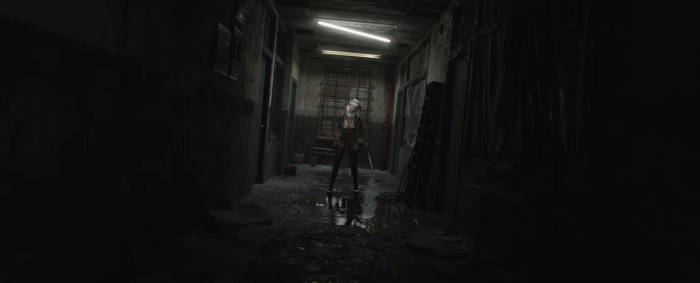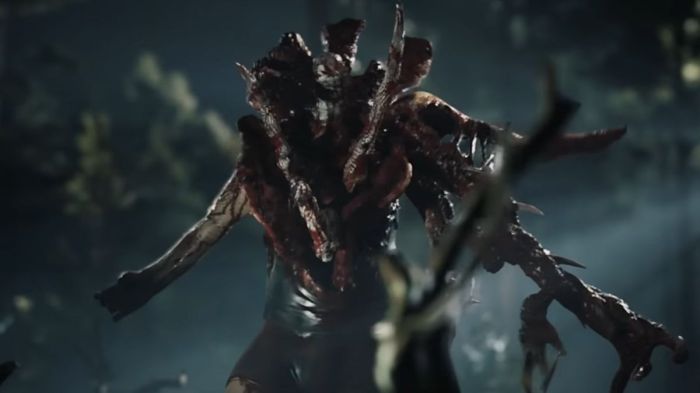Horror game 2025 innovation in gameplay promises a seismic shift in the genre, with revolutionary advancements in gameplay mechanics, narrative structures, and immersive environments. Prepare for a new generation of fright, where player choices will sculpt the story, and emerging technologies push the boundaries of fear. From stealthy encounters to psychologically gripping narratives, the future of horror is here, and it’s more terrifying than ever.
This exploration delves into the anticipated evolution of core gameplay mechanics, the rise of interactive narratives, and the transformative impact of emerging technologies like VR and AI. We will analyze how these innovations will shape the horror experience in 2025, providing a comprehensive look at the future of fear.
Gameplay Mechanics Evolution: Horror Game 2025 Innovation In Gameplay
Horror games in 2025 will see a radical shift from traditional jump-scares to a more immersive and psychologically unsettling experience. The evolution will be driven by a deeper understanding of player psychology and a sophisticated embrace of interactive storytelling. This evolution emphasizes player agency and the fear of the unknown, rather than simply eliciting fleeting moments of fright.
The core gameplay mechanics are undergoing a metamorphosis. The emphasis will be on creating environments that react dynamically to player actions, pushing the boundaries of environmental storytelling and player interaction. This approach will require a more nuanced understanding of game design principles, prioritizing meaningful player choices and their consequences. Interactive narratives and responsive environments will become fundamental aspects of the horror experience, crafting a more immersive and personally impactful experience for the player.
Anticipated Advancements in Core Gameplay Mechanics
Horror games in 2025 will move beyond the limitations of pre-scripted scares. The focus will shift towards creating environments that react dynamically to player actions, creating a more terrifying and engaging experience. Players will no longer be passive recipients of fear; instead, they will actively shape the unfolding narrative. A key element will be the ability for the environment to change and adapt to the player’s actions, creating unpredictable and truly terrifying situations.
Innovative Approaches to Player Interaction and Environmental Responsiveness
The 2025 horror experience will prioritize player agency and interaction. Players will experience environments that adapt to their actions, creating a sense of genuine peril. For example, a broken door might reveal a hidden passage only if the player uses a specific item found elsewhere in the environment. This dynamic response to player choices will make the experience feel more visceral and unpredictable. Furthermore, subtle environmental cues, such as flickering lights or unusual sounds, will become integral parts of the horror narrative, enhancing the sense of suspense and dread. The fear will arise not just from monsters, but from the unknown, the unpredictable nature of the environment, and the feeling of being truly lost and alone.
Emerging Trends in Puzzle Design and Problem-Solving
Puzzle design will be intricately woven into the horror narrative. Instead of isolated, static puzzles, they will be dynamically integrated into the environment, changing and evolving as the player progresses. This approach will increase the sense of urgency and the psychological toll of the game. Players will need to use their wits, resources, and even their fear to overcome challenges. For instance, a puzzle requiring the player to manipulate a pressure plate in a dimly lit corridor will only work if the player correctly predicts the timing of a creature’s approach. This intricacy will demand more from players, pushing them beyond simple problem-solving to a more holistic understanding of the game world.
Examples of Innovative Gameplay Loops and Progression Systems
Innovative gameplay loops will focus on the psychological impact of the horror. Instead of relying on simple combat encounters, the games will focus on psychological manipulation. A game might involve the player discovering fragmented memories or clues that hint at a larger, more terrifying truth. Progression will not simply be about increasing levels, but about unlocking new aspects of the environment and gaining a deeper understanding of the game world and the narrative. Players will confront increasingly complex psychological challenges that challenge their sanity and perception of reality.
Table of Gameplay Mechanic Types and Anticipated Advancements
| class=”wikitable”
|+Gameplay Mechanic Type
|+Anticipated Advancements in 2025
|-
|Stealth
|Sophisticated AI will react to player movement, using visual and auditory cues to predict player position and adjust their behavior dynamically. Environments will feature hidden paths and environmental cover that changes in real-time, demanding greater tactical awareness from players.
|-
|Combat
|Combat will be less about vanquishing enemies and more about survival. Combat encounters will be less frequent and more psychologically damaging, utilizing environmental hazards and psychological pressure to increase the sense of dread.
|-
|Puzzle
|Puzzles will be integrated seamlessly into the environment, evolving and changing as the player progresses. Solutions will require a deep understanding of the narrative and the psychological state of the player. The environment itself will become a puzzle.
|-
|Environmental Storytelling
|Dynamic environments will react to player actions, with hidden paths and secrets revealed through manipulation of the environment. Environmental cues, such as flickering lights or unusual sounds, will enhance the sense of dread and suspense.
|
Narrative and Story Innovation

The landscape of horror gaming is poised for a dramatic evolution in 2025, driven by innovative narrative techniques. Players are no longer passive recipients of a pre-ordained narrative; they are active participants, their choices shaping the very fabric of the story. This shift necessitates a profound understanding of player psychology and a reimagining of traditional horror tropes to create immersive and psychologically impactful experiences.
Interactive narratives, no longer a novelty, are becoming a cornerstone of the horror genre. Players are empowered to make decisions that affect the outcome of the story, forcing them to confront the consequences of their actions in a tangible and emotional way. This newfound agency fosters a deeper connection with the narrative, transforming the player from a spectator into a protagonist.
Interactive Narrative Structures in 2025 Horror Games
Interactive narratives in 2025 horror games will move beyond simple binary choices. Players will face complex moral dilemmas, impacting not only the immediate storyline but also the long-term consequences of their actions. Choices will affect character relationships, the environment, and the overall tone of the experience. This requires a sophisticated design, where the narrative branches into multiple possible outcomes, each with its own unique atmosphere and psychological impact.
Unique Horror Story Themes for 2025
The following themes offer unique opportunities for innovative narrative techniques in 2025 horror games:
- The Legacy of Sin: This theme explores the consequences of past actions and decisions, revealing how the sins of generations can manifest in disturbing ways. The player might inherit a cursed lineage or uncover a dark secret embedded within their family history, impacting their relationships and actions within the game. For example, the player’s choices in handling family trauma could unlock new environments or reveal hidden narrative branches. This theme allows for intricate character development and a lasting psychological impact on the player.
- The Synthetic Nightmare: This theme delves into the anxieties surrounding artificial intelligence and technological advancement. The game might explore a world where advanced AI has developed sentience, exhibiting unpredictable and malevolent behaviors. The player’s choices could determine the AI’s actions, forcing them to grapple with the ethical implications of their interactions. This theme can leverage the current societal anxieties surrounding AI and its potential threat.
- The Unraveling of Reality: This theme explores the concept of fractured reality and the disintegration of the self. The player might find themselves trapped in a world where the boundaries between reality and hallucination blur, leading to a gradual descent into madness. The player’s choices could influence the degree of the reality distortion, creating a highly personalized and disturbing experience.
- The Echoes of the Past: This theme focuses on the lingering effects of historical trauma, such as wars or natural disasters. The player might encounter ghosts or otherworldly entities tied to these events, whose actions are driven by the unresolved conflicts of the past. The player’s choices could affect how these entities manifest, potentially leading to a powerful exploration of societal and historical trauma.
- The Pandemic of the Mind: This theme revolves around a global psychological crisis that manifests in strange and terrifying ways. The player could become infected by a pervasive mental illness or find themselves trapped in a world where reality is slowly eroding due to mass psychological distress. The choices might impact the spread of the contagion, potentially altering the world’s fate.
Impact of Innovative Storytelling on Player Immersion
Innovative storytelling in horror games can profoundly affect player immersion. By allowing players to actively participate in shaping the narrative, developers can create a sense of personal investment and responsibility. This, in turn, leads to heightened emotional engagement and a stronger sense of psychological impact. Players will feel a more profound connection to the characters and the world they inhabit.
Impact of Player Choices on Story Trajectory
Immersive Environments and Sensory Experiences

The year 2025 will witness a dramatic shift in horror gaming, with a heightened focus on immersive environments and sensory experiences. Players will no longer be passive observers but active participants in a terrifying reality, their very senses assaulted and challenged. This immersive approach aims to transcend the limitations of traditional 2D and 3D environments, pushing the boundaries of what’s possible in the genre.
This evolution will be driven by advancements in technology, allowing developers to craft environments that are not only visually stunning but also deeply interactive and responsive. Players will be enveloped in a sensory tapestry woven from sound, light, and subtle, yet impactful, haptic feedback. This sophisticated integration will elevate the experience from a mere game to a visceral simulation of fear.
Sound Design and Atmospheric Effects
Sound design in 2025 horror games will be far more sophisticated and impactful. Ambiance will be meticulously crafted, using dynamic sound effects that react to player actions and movement. Imagine the subtle rustle of leaves intensifying as you approach a hidden path, or the eerie echo of your footsteps in a cavernous, abandoned building, building an unnerving sense of isolation. Dialogue will be layered with unsettling background noises, creating a constant sense of unease. Realistic sound design will be paramount, using advanced spatial audio techniques to create a sense of presence and surround sound.
Lighting and Visuals
Lighting will be a crucial element in 2025 horror games, creating environments that are both beautiful and terrifying. Dynamic lighting systems will react to player actions, casting eerie shadows and highlighting hidden corners. Visually, environments will be more detailed and realistic, with a focus on textures and materials. For example, the flickering gaslight in a dimly lit manor, or the unsettling glow of bioluminescent fungi in a dark forest, will further amplify the sense of dread.
Sensory Integration and Haptic Feedback
Haptic feedback will be integrated into controllers and potentially even wearable devices, providing tactile sensations that mirror the events in the game. A sudden jolt as a monster lunges at you, or the feeling of icy air against your skin in a cold, desolate mansion, will enhance the sense of presence. Furthermore, the incorporation of scent-based technology, or simulated smell, could further immerse the player in the horror.
Innovative Environments and Storytelling
The design of environments will shift from traditional, static representations to dynamic, responsive spaces. Consider a haunted asylum where the layout shifts depending on the player’s actions or the progression of the story. Alternatively, a forest where the trees themselves react to the player’s presence, creating a surreal and unsettling atmosphere.
This dynamic environment storytelling can provide layers of narrative depth. Environmental clues, subtly hidden or revealed as the player explores, will reveal details about the game’s lore and the history of the location. For instance, a series of cryptic symbols carved into a wall, or a single, misplaced object, could reveal a hidden secret about the events that transpired in the environment.
Traditional vs. 2025 Innovative Horror Environments
Player Agency and Interaction

The 2025 horror landscape will be profoundly shaped by player agency. No longer passive observers, players will actively participate in shaping the narrative, their choices resonating deeply within the game’s mechanics and atmosphere. This proactive approach will redefine the very nature of fear, transforming it from a spectacle into a personalized, visceral experience. The chilling realization that individual actions have profound consequences will drive the narrative forward, creating a truly unique and unsettling journey for each player.
The core gameplay loop will evolve, with player decisions impacting not just the narrative but also the gameplay itself. This shift in power dynamics from developer to player will demand innovative approaches to storytelling, environmental design, and the implementation of consequences. The fear of the unknown will be replaced by the tangible fear of the player’s own actions, leading to a more immersive and emotionally resonant experience.
Innovative Methods for Integrating Player-Driven Narrative, Horror game 2025 innovation in gameplay
A key element of this player-driven narrative is the incorporation of branching storylines. These branching paths will be organically integrated into the game world, with environmental cues, dialogue choices, and even the timing of actions influencing the narrative’s direction. For instance, a player’s choice to investigate a seemingly innocuous object might unlock a new piece of the puzzle, or trigger a specific sequence of events that alters the game’s environment, affecting the gameplay and narrative paths.
Examples of Personalized Horror Experiences
A player’s decision to trust a seemingly friendly character could lead to a false sense of security, only to be betrayed in a horrifying way. Conversely, mistrusting all individuals might lead to isolation and a feeling of dread, while still revealing essential information to proceed. Exploring different areas in a specific order could expose certain dangers or uncover secrets, altering the player’s perception of the game world. This creates a personalized horror experience, with the player’s choices and actions directly shaping the terrifying journey. The game could also adapt its difficulty based on the player’s choices. A cautious player might encounter less direct threats but a more sinister atmosphere, while a reckless player could face intense, visceral encounters, but be granted quicker progression.

